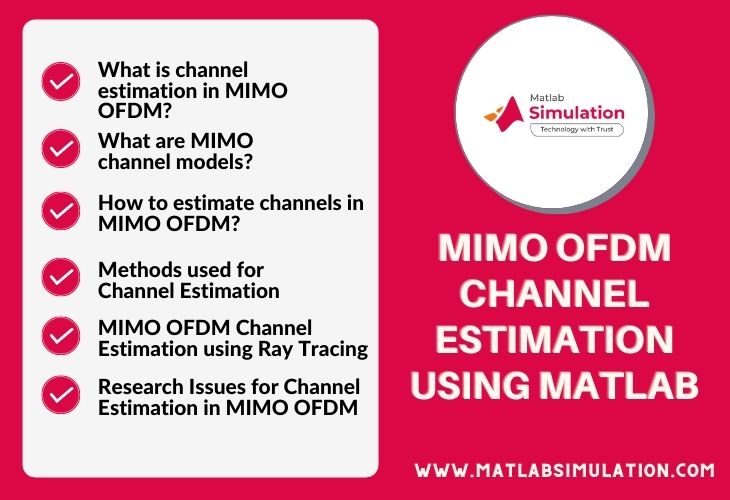Firstly, we need to know the abbreviation of MIMO OFDM i.e. Multiple Input Multiple Output Orthogonal Frequency Division Multiplexing abbreviated as MIMO-OFDM, which is a new mobile broadband communication technology with huge rates of transmission. It shows resistance to multi-path fading and other channel defects.
- Numerous transmitters across one end and several receivers on the other are successfully coordinated in a MIMO system to increase the capability of the channel
- The effectiveness, dependability, and distribution of the spectrum could all be improved with this innovation
- To improve data transmission efficiency, space-time block coding is being used
- For transmission and reception of numerous data streams over a larger number of corresponding antennas, MIMO plays a vital role
- Among the most difficult problems in MIMO-OFDM systems, the most pressing one is obtaining precise channel state information (or CSI) for coherently detecting information symbols
- Specific kinds of estimation methods, like training-based, blind, and semi-blind channel estimating, are being used to acquire channel state information
Through this article, we are presenting to you an overall picture of MIMO OFDM channel estimation using MATLAB. Let us first define MIMO OFDM channel estimation
What is channel estimation in MIMO OFDM?
- As it is said before, to obtain large data rates and higher efficiency in advanced wireless technological applications, a combination of multiple-input multiple-output (MIMO) structures with the orthogonal frequency division multiplexing (OFDM) technology can be utilized
- Standard Least Square (or LS) and Minimum Mean Square (or MMSE) estimation techniques are used in channel estimation
- The Bit Error Rate (BER) and Mean Square Error (MSE) levels are being used to analyze the quality of the MIMO-OFDM systems
For transmitters with M antennas, the other components of the channel can be obtained as follows
- Variance equals 10^(-pathloss/10)
- Where pathloss is the summation of 148.1, 37.6*log10(d) and 8*randn(1) – 10
- And d is the distance in km
- %pathloss + shadow fading – antenna gain
- Finally, channel is calculated as equal to sqrt(variance/2)*(randn(M,1) added to 1i*randn(M,1))
The steps involved in the 3D channel model functioning on large and small scale parameters along With the generation of Coefficients are listed below
- Large scale parameters
- Setting the network layout, scenario and the antenna parameters is the first step
- Assigning propagation conditions with respect to indoor and outdoor situations or NLoS and LoS circumstances is the second step
- Path loss calculation is the third step
- Finally the large scale parameters are generated which include AS, K, DS and SF
- Small scale parameters
- As a continuation, delays and power clusters are generated in steps
- Creating the angles of arrival and departure is the next step
- Then random ray coupling has to be performed
- Generating XPRs form the next step
- For generating Coefficients the following steps are carried out
- Initial phases are drawn
- Channel Coefficients are generated
- Shadowing and pathloss are applied
We discussed the simple methods and compatible steps related to channel modeling in the above description. Please contact our technical support team for more information on all of these areas. Because of the way we guide our consumers, they have been able to create a fantastic research experience for themselves. Let us now talk about the various channel models in MIMO.
What are MIMO channel models?
The various channel models compatible with MIMO are grouped under physical, analytical, and standard heads below
- Physical models
- Stochastic models based on geometry
- One ring, two ring and elliptical models
- Non geometrical stochastic physical models
- Deterministic physical models
- Ray tracing and measurements that are stored
- Stochastic models based on geometry
- Standard channel models
- IEEE 802.11n, IEEE 802.16d and IEEE 802.16e models
- 3GPP 3D, 3GPP 2 and 3GPP spatial channel models
- WINNER II and WINNER + channel model
- SUI and COST 273/259 and 2100 channel models
- Analytical models
- Models motivated by propagation
- Models based on time and space coding
- Finite scatter and maximum entropy models
- Correlation based models
- Kronecker and Weichselberger model
- Rough surface and structured models
- Diagonal de correlation and i.e. models
- Virtual channel representations
In general, the model you choose is mostly determined by the requirements of your project. We are highly familiar with the demands, challenges, and solutions under diverse circumstances because we have supervised several projects on MIMO OFDM networks. Visit our website for a collection of important project ideas on MIMO OFDM channel estimation using MATLAB. Let us now see the steps involved in the estimation of MIMO OFDM
How to estimate channels in MIMO OFDM?
- Estimating channel state information (CSI) is a major concern in wireless technologies
- CSI depicts how digital signals travel from transmitter to the receiver through several pathways at different carrier frequencies
- During both downlink and uplink, CSI must be calculated
- The base station uses orthogonal pilot signals that were sent by the user node to estimate channel length while uplink
- In case of downlink, the base station delivers pilot signals to the user, who recognizes the anticipated downlink channel information
- Different solutions for doing CSI estimation, which typically needs significant computational burden, have indeed been devised thus far
- Such methods are not applicable for 5G wireless communications due to numerous other strategies like MIMO, massive MIMO, OFDM and millimeter-Wave being used in 5G networks
Usually, we guide the research scholars in a more customized manner, by providing them with all the needed explanations as above, which is the prime reason behind our great success. In line with the explained channel estimation procedure, it becomes important for us to talk about the methods involved in the channel estimation process.
Methods used for Channel Estimation
- Low complex Least Square estimation
- Compressed Sensing
- Linear Minimum Mean Square Error algorithms or MMSE
- Deep Neural Networks or DNN
- A Long Short Term Memory network or LSTM
- A Convolutional Neural Network or CNN
Using these methodologies we have worked out numerous successful projects that have received worldwide recognition. From the huge experience that we gained as a result of our dedicated research support, we are capable of rendering ultimate research guidance to you. Let us now talk about the MIMO OFDM channel estimation machine learning algorithms,
Machine Learning Algorithms for MIMO OFDM Channel Estimation
The Machine learning algorithms for channel estimation in MIMO OFDM can be grouped into the following categories
- Supervised learning
- Support vector machines, Regression models and K – nearest neighbours
- These algorithms are associated with learning and classifying user behaviour, localisation of users, detecting and estimating MIMO channels
- Bayes learning and theorem
- It is used in cognitive radio spectrum sensing and MIMO Channel estimation
- Support vector machines, Regression models and K – nearest neighbours
- Reinforcement learning
- Multi Armed Bandits, Markov Decision Process and Q learning
- These algorithms are useful in HetNet cell selection for user association and its resource allocation in small cells
- Spectrum sharing in D2D communication
- Network energy harvesting and making decisions with undetermined channel state information
- Multi Armed Bandits, Markov Decision Process and Q learning
- Unsupervised learning
- K means clustering
- Small cell clustering, associations of HetNets and D2D users find the application of this algorithm
- Principal Component Analysis
- Detecting anomalies
- Intrusions and faults
- Signal dimension reduction
- K means clustering
You can have great ideas on the real-time usage of these advanced algorithms by having talks with our experts. The engineers with us have got enough technical skills to support your MIMO OFDM channel estimation MATLAB projects. Let us now talk about channel state information
- Channel state information (CSI) is a term used in wireless technology to describe the known channel parameters of a network connection.
- This data depicts the cumulative influence of scattering, fade, and energy degradation with range mostly as the signal travels from the transmitter to receiver.
- Channel estimation is the name of the technique. The CSI allows the transmission to adjust to the existing channel circumstances, which is critical for ensuring stable communication with a high rate of data in systems with multiple antennas
We have delivered successful research projects and are part of their real-time executions. So we are highly well versed in technical aspects needed for better ways to obtain channel state information and channel estimation methods. In this respect, let us now see the factors that are the reasons for deviations in the performance of channel estimation.
Factors that influence the performance of channel estimation
Many important aspects that influence channel estimations include the following
- Range of Frequency
- Position and time
- Temperatures, moisture, and weather conditions
These factors are primarily responsible for the quality of channel estimation functioning. So we help our customers to achieve utmost perfection by considering all such factors given above. While working on their OFDM simulation in MATLAB projects, researchers encounter several technical limitations. Let us see some of the important recent challenges in MIMO OFDM channel estimation below
Research Issues for Channel Estimation in MIMO OFDM
- Acquisition of channel state information and channels feedback
- Immediate complementarity and reciprocity of statistics
- Problems with the hardware
MIMO PHY layer enables both uplink and downlink transmissions at the ground and mobile stations. It is also completely continuous and works in real-time. The MIMO System Architecture has many interesting functionalities, which are summarised on our website. We also provide you with a detailed note on the range of MIMO-based application areas. Let us now see the MATLAB features suited for MIMO OFDM channel estimation projects
Matlab features for MIMO OFDM Channel Estimation
The following characteristics of MATLAB software help in estimating channels in MIMO OFDM
- Supportive to massive MIMO Matlab, SU – MIMO and MU – MIMO
- Base station and mobile station antennas in the range of 2 to 128 and 12 respectively
- LTE reconfigurable framework and 12 spatial streams support
- 50 MHz to 6 GHz frequency range and 20 Megahertz Bandwidth for TDD uplink and downlink
- Provides for over the air synchronisation and open loop power control and AGC
- Enables calibration of channel reciprocity on the basis of precoding
- Provides support for QAM in powers of four (4 QAM, 16 QAM, 64 QAM and 256 QAM)
- Supports Fundamental MAC functionality for data transmission based on packets in both up and downlink for enabling applications related to data streaming and video transmission
Along with technical assistance in handling MATLAB, we have a group of professional writers and developers who can surely help you produce a superior thesis, paper, or assignment on MIMO OFDM channel estimation. We are your one-stop destination for all of your research questions.
MIMO OFDM Configuration for channel estimation
- Physical wave propagation consist of the following models
- Deterministic (Ray Tracing and Stored Measurements)
- Stochastic methods
- Geometrical (GSCM)
- Non geometrical
- For configuration of antenna bandwidth in the MIMO channel matrix the following analytical models are considered
- Propagation motivated models (virtual channel representation, maximum entropy model and finite scatter model)
- Correlation based models
- Standardized models consist of the following
- WINNER, IEEE 802.16e and SUI
- COST 273 and 259, 3GPP SCM and IEEE 802.11n
For more insight into the protocols, coding, and other technicalities involved in configuring MIMO OFDM systems for channel estimation, you shall contact us at any time. We help you in implementing all your ideas in real life. Also, we provide necessary support on project simulation. Simulators for MIMO OFDM networks are mostly used to evaluate the results or consequences of your idea. Simulators can be used to quickly get the results of a project’s performance under various conditions before actually making applications out of them. Let us now talk about MIMO OFDM simulation parameters,
Simulation parameters for MIMO OFDM Channel estimation
- The generalistic simulation parameters used in MIMO OFDM Channel estimation are as follow
- Channel estimation (ideal)
- Horizontal (4) and vertical (8) antenna ports and elements
- Antenna element gain (8 dBi), horizontal (0.5) and vertical (0.8) inter element spacing
- Horizontal and vertical HPBW (both at 65 degree)
- The azimuth domain and elevation domain parameters consist of the following
- The respective angular distributions (Laplacian and Von Mises for Elevation and Azimuth respectively)
- Departure angular spread at elevation and azimuth (8 and 6 degree)
- Mean AoD in elevation and azimuth (90 degree and 0 respectively)
- Port downtilt angle at elevation only (90 degree)
- The ITU antenna parameters are as follows
- Vertical (15 degree) and horizontal (70 degree) HPBW antenna port
- Horizontal directional antenna ports (4)
- Antenna port gain (17 dBi)
In general, we concentrate on the research project’s goals to select the best network modeling tool for MIMO OFDM networks. We also keep our customers up to date on new simulator innovations regularly. Hence, you can contact us for technical assistance with any simulation software.
MIMO OFDM Channel Estimation using Ray Tracing
This section illustrates the way of performing indoor ray tracing and utilizes the data to create a MIMO-OFDM channel model at link-level simulation which was designed successfully by our technical experts
- At the transmitter side the source bits are first sent for LDPC encoding while a part of the source bits are sent for the calculation of BER
- Then in turn they are sent for QAM and OFDM modulation
- Through the Deterministic Ray Tracing Channel and AWGN the modulated data bits are sent for perfect channel estimation and OFDM demodulation respectively at the receiver section
- Then the signals are fed to equalization module then to QAM demodulation and then LDPC Decoding
- Finally the BER calculations are also matched
Not only does the suggested methodology improve channel estimation efficiency, but it also minimizes pilot overhead, conserving spectrum and energy. All of the MIMO OFDM network research issues that we are currently guiding are current and hot. In all of these areas, you can expect thorough research assistance from us for MIMO OFDM CHANNEL ESTIMATION USING MATLAB. Our dedication and professionalism have made us famous among researchers all over the world. In general, we want you to develop a top-level technical understanding of your research topic.














